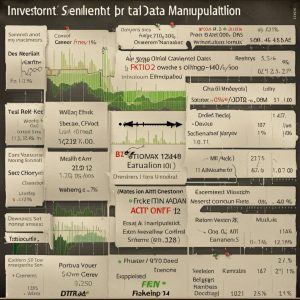
A Comprehensive Guide to Trading with Aroon Oscillator
April 30, 2024
Introduction
In the world of technical analysis, traders are always looking for robust tools to help them navigate the complex landscape of financial markets. One such tool is the Aroon Oscillator, a versatile indicator that has gained popularity among market technicians since its introduction by Tushar Chande in 1995.
In his book “Technical Analysis of the Financial Markets,” Renowned market technician John Murphy emphasizes the importance of identifying trends and their strength. He states, “The most important thing to remember about indicators is that they should be used to supplement and confirm your basic trend analysis, not as a substitute for it.” The Aroon Oscillator aligns perfectly with this philosophy, as it helps traders identify trend changes and gauge the strength of a trend.
Another prominent market technician, Martin Pring, highlights the significance of momentum in his book “Technical Analysis Explained.” He notes, “Momentum is an important concept in technical analysis because it can help identify the strength or weakness behind a price trend.” As a momentum indicator, it provides valuable insights into a trend’s underlying strength, making it an essential tool in a trader’s arsenal.
In this comprehensive guide, we will explore the intricacies of the Aroon Oscillator, including its components, calculation, and interpretation. We will also discuss how traders can effectively integrate this powerful indicator into their trading strategies to make informed decisions in the fast-paced world of financial markets. By the end of this guide, you will have a solid understanding of how the Aroon Oscillator can help you identify trends, gauge their strength, and improve your trading performance.
What is the Aroon Oscillator?
The Aroon Oscillator is a momentum indicator that helps traders identify trend changes in the market. It is a technical analysis tool that uses the Aroon indicator, which measures the time elapsed between the lowest low and highest high over a specific period. The Aroon Oscillator is calculated by subtracting the Aroon Down from the Aroon Up.
How is the Aroon Oscillator Calculated?
The Aroon oscillator consists of two lines, Aroon Up and Aroon Down, derived from the Aroon indicator before being combined into the oscillator:
1. Aroon Up measures the number of periods since the highest high price over a specified lookback period occurred, typically 25 periods.
2. Aroon Down calculates the periods since the lowest low price happened over the same lookback period.
These components range from 0 to 100. Aroon Up approaches 100 when a new high is set, while Aroon Down moves closer to 100 after a new low is established.
The oscillator is obtained by subtracting Aroon Down from Aroon Up, resulting in a range between -100 and +100. Positive values indicate uptrend strength, while negative values reflect downtrend strength.
As new highs or lows form, the oscillator swings closer to the -100 or +100 extremes, reflecting the developing trend’s strength. Readings near zero indicate consolidation and lack of trend. Crossovers of the zero line can signal trend reversals.
Traders can experiment with the lookback period to find the optimal setting for their timeframe. The Aroon Oscillator provides a straightforward method to gauge trend direction and strength but should be used with other technical analysis tools for informed trading decisions.
How to Use the Aroon Oscillator?
The Aroon Oscillator is a versatile indicator that traders and investors can use to identify potential trend changes and evaluate trend strength. Here are some key ways to use the Aroon Oscillator:
- Crossovers: When the oscillator crosses above zero, it signals a new uptrend, while a crossover below zero indicates a fresh downtrend. These crossovers can act as trade triggers for entering or exiting positions.
- Trend Strength: The strength of the emerging trend can be evaluated based on how far the oscillator is from the -100/+100 thresholds after the crossover. The farther from zero, the stronger the new trend.
- Pullbacks: Traders may look for pullbacks to the zero line after crossovers enter with momentum in the new trend’s direction.
- Trend Weakness: Monitoring the oscillator for swings back to the zero line during strong trends provides information on possible trend weakness or exhaustion.
- Divergences: Divergences between the price and the oscillator can act as warnings for potential trend changes.
- Overbought/Oversold Levels: Some traders use levels like -75/+75 to anticipate mean reversion.
Example: In 2021, the Aroon Oscillator for Apple (AAPL) stock crossed above zero in January, signalling a new uptrend. The oscillator then remained positive and close to +100 for several months, confirming the strength of the uptrend. Traders could have used pullbacks to the zero line as buying opportunities during this period. The Aroon Oscillator is most effective when combined with other indicators like moving averages to confirm signals. Multiple time frame analysis using the oscillator on short- and long-term charts can provide additional confirmation for trade signals.
Aroon Oscillator Trading Strategies
1. Trend Following Strategy:
– Buy when the oscillator crosses above zero and returns to the zero line.
– Trail stops below each subsequent higher low in an uptrend.
– Exit when the oscillator crosses back below zero or drops below -75.
– Short when the oscillator moves below zero and rallies to the zero line.
– Trail stops above each lower high in a downtrend.
– Exit when the oscillator crosses back above zero or rises above +75.
2. Reversal Strategy:
– Watch the oscillator cross below +75 or +50 in a strong uptrend, signalling a potential reversal.
– Enter short positions on rallies back to the zero line following a bearish crossover.
– Place stops above the recent swing high and target oversold readings near -75.
– Monitor for bullish divergences when the oscillator is near -100 in a downtrend.
– Enter long positions on pullbacks to the zero line following a bullish crossover.
– Place stops below recent lows, target overbought levels, or move back below zero.
3. Divergence Strategy:
– Identify bearish divergences when the price makes new highs, but the oscillator fails to confirm.
– Interpret bearish divergences as potential signals for trend reversals or corrective pullbacks.
– Spot bullish divergences when the price creates new lows, but the oscillator does not confirm.
– View bullish divergences as possible signs of upcoming bullish reversals or upward moves.
– Validate divergence signals with additional analysis and confirmation from other indicators.
Example: In 2021, the Aroon Oscillator for Apple (AAPL) stock crossed above zero in January, signalling a new uptrend. The oscillator then remained positive and close to +100 for several months, confirming the strength of the uptrend. Traders could have used pullbacks to the zero line as buying opportunities during this period.
Remember to combine the Aroon Oscillator with other indicators, price action analysis, and risk management techniques for more reliable trading decisions. Backtesting and practice can help evaluate the effectiveness of these strategies for your specific trading style and goals.
Advantages and Disadvantages of the Aroon Oscillator
Advantages:
1. Easy to Interpret: The Aroon Oscillator is relatively simple to understand and use, making it accessible to traders of various experience levels. It indicates trend direction and strength.
2. Identifies Trend Changes: The oscillator detects potential trends, helping traders anticipate reversals or new trends. This allows for timely adjustments to trading strategies.
3. Complements Other Indicators: Combining the Aroon Oscillator with other technical tools, such as moving averages or the Relative Strength Index (RSI), can enhance analysis and increase the reliability of trading signals.
Disadvantages:
1. False Signals in Choppy Markets: The Aroon Oscillator may generate false or conflicting signals in range-bound or choppy market conditions, where price lacks a clear trend. Traders should exercise caution and confirm signals with other indicators in such environments.
2. Lagging Indicator: As a lagging indicator, the Aroon Oscillator provides signals after a trend has begun, potentially causing delayed entries or exits. Traders may miss early opportunities within a new trend.
Example: In 2020, the Aroon Oscillator for Amazon (AMZN) stock generated a bullish signal in April when it crossed above zero, confirming the start of an uptrend. However, in September, the oscillator produced a false bearish signal during a choppy period, highlighting the importance of confirming signals with other indicators.
Conclusion
The Aroon Oscillator is a valuable tool for identifying market trend changes, offering several advantages to traders:
1. Simplicity: Its ease of calculation and interpretation makes it accessible to traders of varying skill levels, allowing for quick analysis and decision-making.
2. Trend Change Detection: The oscillator is a reliable indicator of potential trend shifts, enabling traders to adjust their strategies accordingly and capitalize on emerging market opportunities.
3. Strategy Enhancement: Incorporating the Aroon Oscillator into a trading strategy, especially when combined with other technical indicators and comprehensive market analysis, can improve confidence in trading decisions and overall performance.
However, traders should be aware of the oscillator’s limitations:
1. False Signals: In choppy or range-bound markets, the Aroon Oscillator may produce false signals, potentially leading to incorrect trading decisions.
2. Low Volatility Environments: The oscillator may be less effective when price movements are limited, failing to provide significant signals.
To maximize the effectiveness of the Aroon Oscillator, traders should:
1. Combine with Other Tools: Utilize other technical indicators or complementary tools to strengthen analysis and confirm signals.
2. Practice Risk Management: Employ proper risk management techniques to protect capital and minimize potential losses.
3. Backtest Strategies: Thoroughly backtest trading strategies incorporating the Aroon Oscillator to assess suitability and reliability within their specific trading style and objectives.
Example: A trader using the Aroon Oscillator to analyze the S&P 500 index in 2022 might have identified the bearish trend change in January when the oscillator crossed below zero. The trader could have profited from the subsequent downtrend by confirming this signal with other indicators and implementing proper risk management.
In conclusion, the Aroon Oscillator is a powerful tool for detecting trend changes. Still, traders should be mindful of its limitations and use it in conjunction with other analysis methods to make informed trading decisions.
A World of Ideas: Articles That Will Expand Your Horizons

Becoming a Better Investor: Key Strategic Moves

Investing in a Bear Market: Ignore the Naysayers

Buy the Dip: Dive into Wealth with this Thrilling Strategy

Resource Wars: Navigating a Shifting Global Landscape

Stock Market Sell-Off: Embrace Fear & Seize Opportunities

The Prudent Investor: Prioritizing Trends Over Speculation

Optimal Strategies for The Best Stocks To Invest Long Term

Market Correction Definition: Myths and Realities

Seizing Dominance: The Relentless Rise of Mental Warfare

Stock Market Predictions Today: Americans Fear The Market
Investor Sentiment Survey Defies Stock Market Crash Outlook

What is Inflation? Unveiling Effects and Strategies for Mastery

The Cycle of Manipulation in Investments
Market Opportunity: Buy The Fear & Sell The Noise

Investor Sentiment Data Manipulation: Unveiling Intriguing Insights


